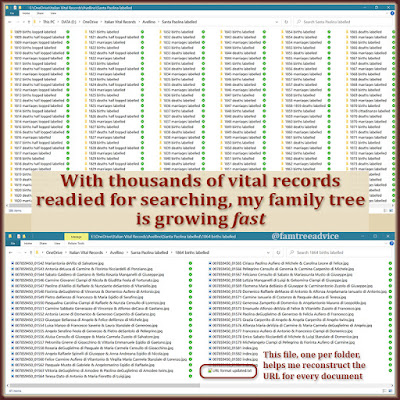I've recently identified hundreds of my cousins from Santa Paolina, Avellino, Italy. I found them in the town's thousands of 1809–1945 vital records. Now I want to find some living cousins.
To find descendants of the town, I turned to my Ancestry DNA matches. I like the different options they have for filtering your matches. A handful of last names from Santa Paolina are closely tied to me. I can filter my DNA matches to show only those with a specific last name in their family tree—even if it's a private tree.
Finding a Likely Cousin
I picked one of my family names from the town at random: Ricciardelli. Then I filtered my DNA match list to show only those with Ricciardelli in their family tree. I chose a DNA match who's in the 4th–6th cousin range for me.
I should tell you that my closest relative from this town is my 2nd great grandmother. I would not expect to find any very close DNA cousins—other than the cousins I grew up with.
I took a look at this 4th–6th cousin's family tree and found only one Ricciardelli. But there were quite a few positive things about her:
- This Ricciardelli woman was born in 1879, which is well in range of the available vital records.
- My DNA match knows the woman's exact birth date, making her easy to positively identify.
- My match listed the woman's hometown as Alvelena, Italy. That doesn't exist, but I'll bet this was how her family heard "Avellino" get passed down through the years.
- The woman died in the U.S., which means I can find immigration and census records for her family.
 |
| By pure coincidence, a family I worked on last week belongs to today's DNA match. |
Following a Path to My DNA Match
My recent deep dive into Santa Paolina records taught me a lot. I know which names are common and how to spell them. It was obvious my match had Americanized the woman's first name. And she misspelled her middle name a bit. So I went right after this Ricciardelli woman, using her correct name.
I launched a search program on my PC called Everything. I typed in Maria Diamante Ricciardelli. There were two of them, both born to the same parents. The 1877 baby was actually Diamante Maria, while the 1879 baby was Maria Diamante. Surprisingly, there is no death record for the first baby. Were they purposely trying to mess with future genealogists?
I checked to see if Maria Diamante Ricciardelli's parents were in my family tree. They were! Her father Emanuele is my 1st cousin 5 times removed. His father Samuele is my 4th great uncle, and his father (also Emanuele) is my 5th great grandfather. I can take Maria Diamante back 4 generations to my 6th great grandfather, Saverio Ricciardelli, born about 1741.
Figuring Out Our True Relationship
Maria Diamante Ricciardelli is my 2nd cousin 4 times removed. I saw that when I put her name into Family Tree Maker. She appears to be the great grandmother of my DNA match. So, what does that make us to one another?
Trying to figure this out was worse than trying to split a bill seven ways at a restaurant. Without a calculator. I needed a chart to make it clear how I'm related to a descendant of a person with a known relationship to me. I've published a relationship calculator before. It has its purpose, but it wasn't exactly what I needed now. It doesn't tell me how I'm related to the great grandchild of my 2nd cousin 4 times removed.
I made a new chart you can download called Cousin Connection. I've highlighted all the "full cousin" relationships in green (1st cousin, 2nd cousin, 3rd cousin, etc.). NOTE: If you are unable to download the file, please let me know. I can add it to a different location.
 |
| Use this chart to take the guesswork out of distant cousin relationships. |
How to Use the Chart
Maria Diamante Ricciardelli is a descendant of my 5th great grandparents. So I'll start at Column G, the 5th Great Grandparent column. She is 3 generations below my 5th great grandparents, so I'll go down the column 3 cells. This cell (G4) places Maria as the great grandchild (look to the left at Column A) of my 5th great grandparents. It says she is my 2nd cousin 4 times removed. So far, so good.
To see how my DNA match is my cousin, I'll move down Column G 3 more cells. That's how many generations below Maria she is (child, grandchild, great grandchild). That puts us at cell G7. That tells me she is my 5th cousin once removed.
Based on our amount of shared DNA, Ancestry DNA said we were in the 4th–6th cousin range. Now I can see exactly what to call our relationship, and it does fall in that range. We are 5th cousins once removed.
After I add Maria's birth record to my family tree and follow up with U.S. documents and facts, I'll write to this DNA match.
Telling her our exact relationship is much better than saying, "Your great grandmother's grandparents are my 5th great grandparents." Don't you agree?
I hope this chart will be a useful tool for calculating your relationships to cousins, too.



